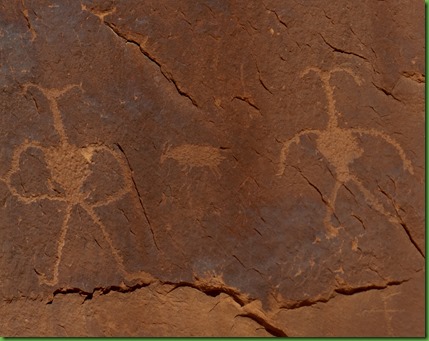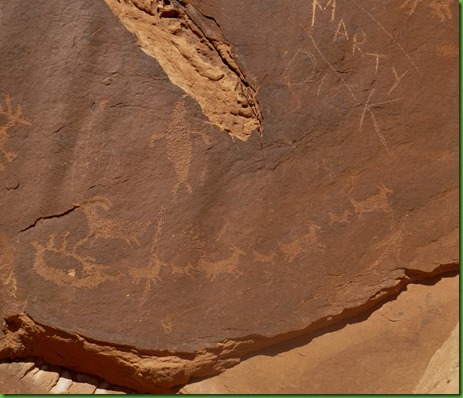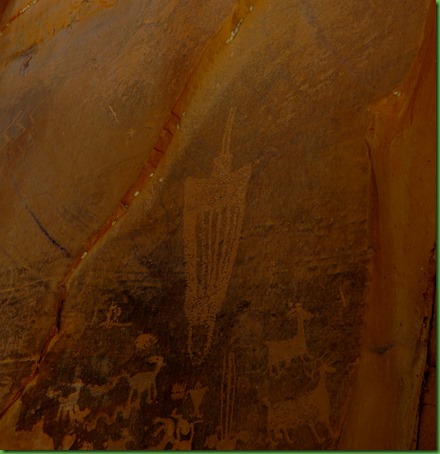Saturday September 6, 2014
Portal RV Park near
Arches National Park
Moab, Utah
I am very interested in Native American cultures both today and in the past. Knowing Moab has numerous examples of Indian rock art, we decide to spend the morning exploring it. The Visitor Center provided information about the rock art here and the people who may have created it as well as a list of several places to go and see it.
There are two types of rock art: petroglyphs and pictographs. Petroglyphs are motifs that are pecked, ground, incised, abraded, or scratched on the rock surface. Pictographs are paintings or drawings in one or more colors using mineral pigments and plant dyes on the rock surface. Many images may have originally been executed as a combination of both techniques, most of them now appear only as petroglyphs because the paint material has faded or washed away over many years.
Rock art was produced by many and varied historic and prehistoric peoples over thousands of years. From the visitor center I learned about the specific people in this area. The Paleo-Indians are considered to be the first humans in the area. Living in the Pleistocene era, they were big game hunters of mammoths and mastodons. A later culture called Archaic, probably used central base camps during their seasonal occupation of this area for harvesting wild plants and animals.
The Anasazi (also now known as the Ancestral Puebloans) whose culture centered south of Moab in the Four Corners area, were primarily cultivators of corn, beans and squash. As such they made their homes here and also harvested a wide variety of wild resources, such as pinion nuts, grasses, bighorn sheep and deer. The Fremont people, who were contemporaries of the Ancestral Puebloans also grew corn and were apparently more dependent on hunting and gathering wild resources than were the Anasazi. Their territory was mainly north of the Colorado River, but overlapped with the Anasazi at Moab. The Anasazi and Fremont are classified by scientists as "Formative" cultures.
The most recent inhabitants are the Notah People (the Utes) who have have been in southeast Utah since the 1200's. They were a very mobile hunting and gathering people who moved in from the Great Basin. They used the bow and arrow, made baskets and brownware pottery, and lived in brush wickiups and tipis. The Notah lived freely throughout western Colorado and eastern Utah until about 1880, when they were forced onto reservations.
The visitor center also provided interesting general information about dating rock art. It is very difficult to establish an exact age of rock art but there are some clues. For example, whenever a horse and rider is depicted, the date is thought to be after A.D. 1540 when the Spaniards reintroduced the horse to the New World. The presence of bows and arrows probably indicates a date after A.D. 500, the generally accepted time period for their appearance in this area.
We know that petroglyphs are commonly found on the black or brown surface of rock cliffs called desert varnish. They are found on the straight, smooth, red sandstone found in the Navajo and Wingate formations. The directions are fairly general so mostly we are on our own with more or less success.
This is a driving tour and our first stop takes us to the Golf Course turn off. We travel from the campground south through Moab and out of town about 4 miles. We turn into a neighborhood and drive past the fire station to a desert varnish just beyond someone’s driveway. There is a small pull out. The pictures in the above paragraphs are all from here.
This art is from the Formative Period of the Anasazi and Freemont Cultures. You can see that in some areas the desert varnish has warn away or been scraped away. It makes me wonder what we are not seeing. But some of what we are seeing are human figures, elk, canines, big horn sheep. In the 3rd picture the art is starting to fade and sadly has been marked over. What in the world makes people do this?
This panel has many images. These are just a few of them.
This last picture is known as the reindeer and sled. That’s not what it looks like to me and obviously that’s not what it was to these peoples. I have darkened some of these images to make them more visible.
On our way back to the main road, we pass one of the more interesting “ranch gates”. These sorts of “entry ways” are very common in the west but this one is actually funny. He’s built himself an arch and look what’s on top.
From here we drive over to Kane Creek Boulevard to what is known as Moon Flower Canyon which is along a section of the Colorado River. These figures are much harder to see and have been vandalized possibly because they are so easy to find with a sign in front of them. The sign reads:
“The Sandstone cliffs before you represent an outdoor gallery or holy place during the ancient times. Native Americans painted or chipped their religious visions, clan symbols or records of events onto the cliffs. These figures date from the archaic to formative periods. There is a Barrier Canyon style figure (a large triangular shape with headdress), deer, big horn sheep and a number of abstract elements.” Barrier Canyon style art is estimated to be between 1500 and 4000 years old.”
We travel on down the canyon to a point 5 miles from the start of Kane Creek Drive. There are two small pull outs and a small sign. There is another car parked in the first pull out so we use the second and walk back.
What we find might be described as a newspaper rock. It is a large boulder with rock art on all four sides.
There is a variety of figures and periods from the Formative to the historic Ute period. There is a figure that appears to be a birthing scene. There are various animal forms, such as a centipede, feet or perhaps bear paws and a snake, as well as triangular anthropomorphic human figures and what appears to be a path of tracks and perhaps even a map.
We turn the car around and head back toward town driving slowly and looking at the rocks along the road for the flat desert varnish that might have rock art. Eagle eye David spots some. Boy his scanning skills are incredible although am I worried that he’s doing this while driving? Yes, constantly. Is that an arrow the person has over his head? An atlatl? Is he shooting the animal?
Further back the road, I spy some and we back up to the pull out.
As we continue down the road we find signs that people are living in caves in the rocks. There are structures built right up to the rocks and no trespassing signs. This is the only one I took a picture of but there were several.
There is a structure that looks like a kiva. This is some interesting neighborhood.
And then we come to a real mystery where there is a parking lot to pull in to. This is beautiful stone work, built right into the rock wall with what appear to be alters inside but no signs, no doors, no indication of what it is. Notice the rounded wall and the designs on the outside. Sorry about the shadows. If you have been to Moab, and know what this is, please let me know. I’m so curious. It’s on Kane Creek Drive.
Look at the way this structure is built into and around the rock. Amazing. Mighty fine masonry.
It’s getting into the afternoon and we have one more stop to make before we go in out of the heat. So we get on our way and head back out to Rt 191, the main road through Moab. We are north of town now and heading back toward the campground when we stop to find the art at Courthouse Wash.
This is the same Courthouse wash inside the park only now it’s out on the main road.
There is a nice map in the parking area and we set out. But there has been some major flooding here and perhaps even a rock slide and the trail is no longer clear, at least not to us. We look all around. We climb around where the trail “should be” but we cannot find it.
We read that this site is on the National Register of Historic places but we sure can’t find it. I hope we aren’t idiots and it’s right in front of us. While we are looking for the trail and the cairns, we didn’t remember the sign said we could walk up the wash to find it. Darn!
But 3 out of 4 isn’t bad and we still have this evening after it cools down on this our last day in Moab.





















































Thanks for the rock art, I am always amazed by it. Lasts longer than paper and a great view into the past.
ReplyDeleteRock art like this really speaks to my inner archaeologist. I've seen petroglyphs from the area in photographs before, and it's such dynamic work. It also reinforces the intricate culture of the area.
ReplyDeleteBoy, you found a lot of writing. What a great driving trail. Love the fellows arch with the car on top!
ReplyDeleteNeat rock art and what a fun arched ranch gate. I love the mystery structure!
ReplyDeleteYou definitely got better pictures than I did and learned a whole lot more too. Great short lesson on the petroglyphs of that area. I remain intrigued by most of these but especially the reindeer and sleigh. Maybe there were different deer in the day of these figures. Perhaps it was a dream before a hunt. We'll never know.
ReplyDeleteI will never understand folk's need to deface things. . .but especially things that obviously have value. . .and can never be replaced. . .thanks for the great pics today!
ReplyDeleteWhy people feel the need to write their names on things is beyond me. Great wall art ... and, by the way, the sleigh and reindeer ... all it's missing is Santa.
ReplyDeleteAmazing that the art has lasted all these years. I cannot figure out why some people (aka idiots) have to vandalize such historic treasures! :c(
ReplyDeleteOn the hunt for rock art-neat idea for a day. There is a lot of history there. Nice colors to the rocks. I enjoyed that very informative tour!!
ReplyDeleteI love the arch for the ranch. I guess we know what he loves to do for fun.
ReplyDeleteInteresting that the Fremont were there the same time as the Anasazi and yet there is comparatively little said about them. I find it wonderful that we don't know for sure what the drawings mean.....somehow it seems right that the ancients get to keep some secrets. That four-sided rock looks like a crossroads of sorts, with very different stories on each side - information on what was ahead in that direction? I love these old records, and can't wait to put my face to them.
ReplyDeleteYou found some great rock art. But I think that last structure isn't really very old.
ReplyDeleteOh no Gaelyn I didn't mean to imply it was old. It's obviously new but very beautifully done. What is it is what I want to know,
DeleteLooked for Winnona on the way by today from rt 64. You keep her well hidden. LOL
ReplyDeleteVinny
We also love the ancient rock art of the Southwest and enjoy searching for it on our hikes. It's such a thrill to find pictographs and petroglyphs in hidden places. You're right, the directions are often not precise—which is probably a good thing to keep vandals away. We found some fabulous rock art in Cedar Mesa last year in some remote areas. Great photos!
ReplyDeleteWe've enjoyed some of the rock art in Moab, you've given us some new places to see.
ReplyDeleteThe birthing scene was my favorite when we hunted out rock art in Moab. Looks like they've put in a sign since we've been there!
ReplyDelete